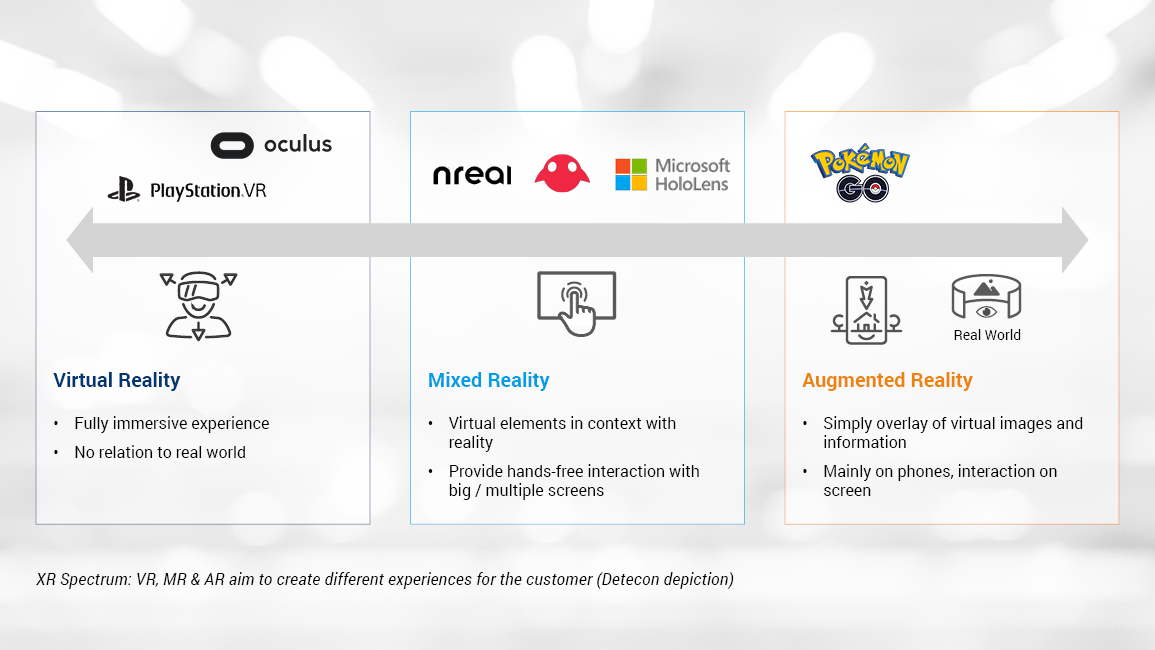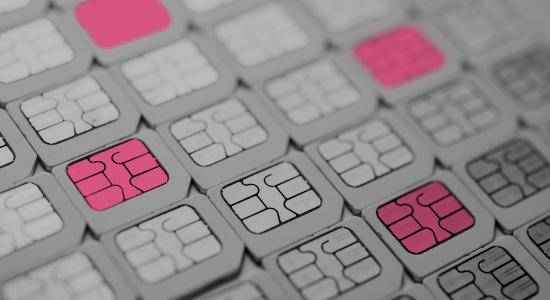Almost a decade after the launch of Google Glass, there are new and exciting developments taking place in the world of Extended Reality - or XR in short. Next to the soaring business of Facebook’s Oculus ecosystem, there are also the first, Mixed Reality (MR) Glasses like the Nreal reaching the hands of consumers since late 2020. However, as shown by Nreal’s recent collaborations & launches in Europe & Asia together with Deutsche Telekom, Vodafone, KDDI & LG Uplus, it seems also Telcos appear to benefit on these new industry trends.
In this interview with Tiana Trumpa (Team Lead, XR Innovation at Deutsche Telekom AG) and Terry R. Schussler (Senior Director, Spatial Computing at Deutsche Telekom AG), we want to discuss the future of the XR industry particularly for Telcos and find out if and how XR will potentially impact their future business.
Detecon: What is meant by the term XR?
Tiana: XR is an umbrella term and spans a continuum consisting of Virtual Reality (VR) on one side and Augmented Reality (AR) on the other side. The difference is that in VR, the user is embedded completely in an artificial environment with no relation to the “normal” world around him – imagine being for example in “the Matrix”. On the other side, there is Augmented Reality, which simply overlays virtual content into your “normal world” – imagine for example playing Pokémon Go on your mobile phone.
Terry: The key piece is in the middle. Mixed Reality (MR) combines the best of these both worlds, where digital content and reality cohabitate the same space. Directly connected and not just an overlay, for example, when a virtual ball hits a real wall, the ball magically knows to bounce back. In particular, it is about the interaction. Software will learn what we do. The interaction between the two worlds should become seamless – this will lead to people moving from a 2D to a 3D interaction model with digital content.

Why is this relevant for a Telco company as a connectivity provider?
Tiana: Our communication and interaction will change as artificial and real world will grow closer together. We will move away from screens and enter completely new experiences in 3D. In addition to making our existing entertainment offerings fit for XR, we also need to prepare our network beyond just the size of our data pipes and focus more on the intelligence and responsiveness of our networks. This will be an essential part of the value proposition in XR in the future, empowering Telcos to deliver a consistent user experience.
Terry: The implementation of XR requires massive amounts of data, not only virtual elements, but also data about the real world, including geolocation data. Up until now, entering new worlds was only possible by wearing a couple of pounds of expensive technology on your head to collect and process this data. A significant reduction of weight, size and price of devices is made possible when computing power is moved off of the head-worn device. In a first step to the smartphone, in a second step, to the edge of the network. For experiences in XR to become increasingly realistic more data needs to be processed and streamed in real time. So eventually, the network becomes an essential part of the product.
The collection of data will lead to various companies in the future trying to generate a 1:1 copy of the real world. This will be essential to make real and virtual worlds merge with each other. Companies like Niantic are already making a significant effort to gather this data. However, hosting and providing this data is the responsibility of a Telco edge cloud – for reasons of technical capabilities and security. So we also need algorithms in the network to manage this data and update changing items e.g. real-time crowd sourced data.
With the recent launch of Nreal in Japan and Korea, we are now seeing the first MR glasses available to end customers. Where is the XR Industry currently?
Terry: The massive success of the Oculus Quest has shown that there is a viable business potential for VR. Already in 2018, their users were willing to pay 100$ on average for software within the first 6 months – that seems like a sound business model and could be a blueprint for consumer XR in general. The tipping point for success was a great combination of three components:
- Price
- First-time user experience
- Content & applications
On the AR/MR side in turn, there are very simple as well as high-end devices on the market. In the middle is a big gap where Nreal gets in. Compression will happen in the middle, where the right combination of price, first-time user experience and content for the consumer will matter. In particular, the software ecosystems that enable mixed reality development are also currently in their infancy. Creating decent computer vision based on very basic cameras is a major challenge. We can see this problem being addressed with e.g. the LiDAR camera in the new iPhone 12 models.
Tiana: XR in sum is at a very early stage. Mixed reality in comparison to VR is somewhere between 3 to 5 years behind. It is essentially a chicken & egg problem: You need to amaze users with a critical mass of content – but the developers only start to create apps if there are enough users to pay for them in the first place. As history has shown, these new product categories need a spark to come to life.
With Nreal as a MR device, we are still at the beginning of a long journey. Hardware and form factor will improve; cables will disappear. Content and applications are currently happening in 2D and 3D content will only pick up speed when SW & HW open up new possibilities. But already today we can see an emerging application portfolio to satisfy the demands of early adopters, such as video streaming and new 3D content applications.
XR will gain importance in the next few years. What concrete business potential does it offer for Deutsche Telekom and what do you need to do today to take advantage of it in the long term?
Tiana: Of course, we want to make revenue with XR and the business potential is far from exhausted. For example, we can act as an aggregator for social / cultural events, etc. This is about co-experiencing even if this is not physically possible. We bring people closer together digitally!
In general, XR enables completely new advertising spaces. What the customer sees can be processed, and intelligent advertising can be placed accordingly. I see it as our duty as a Telco to generate value for the customer and not just bombard him or her with advertising space. It is about more transparency & choice, all the while privacy protection must come first.
As mentioned earlier, we believe that our network will be an essential part of the XR ecosystem in general. Eventually, we will host some parts of future XR experiences on our Edge Cloud, which are subsequently delivered via our 5G network towards the end user. Playing an essential part on this orchestration process will allow us to develop completely new business approaches.
Terry: Practically, we can do a lot without 5G & Edge even now. You do not need that to have a great XR experience. But you can deliver a much better experience! In the future, there will be use cases that require 5G to offer completely new experiences. Getting this latency down and the movement synchronized is essential for a good multi-user experience. So, giving developers access to render their apps in our edge network via APIs to overcome this challenge could also be a potential business model, but these are very early thoughts.
First, however, we will extend our existing consumer 5G and entertainment offerings to include an XR experience. On the business side collaboration is a key topic. Here, there are several use cases we are exploring at the moment, such as to accelerate learning curves, supporting field advisors, or enhancing collaborative virtual meetings with shared whiteboards.
To develop the best customer experience in the long run, you also try out a lot of new things. What are your favorite applications in XR now and how do you imagine a day in the year 2025?
Terry: Currently, simple apps drive me. In VR definitely: Pro Putt! - a mini-Golf Game to play at home and in MR I would say: Angry Birds. I loved that game already on Smartphones. Big Fan… but adding a third dimension to it is very cool and a lot of fun.
In 2025, I expect a hands-free everyday life. My calendar as well as important news are displayed directly in my field of view. I would use XR glasses throughout the day. Data is constantly provided to me, based on my habits. Using eye tracking, I will be able to see objects in different ways, e.g. colors.
Tiana: Well, I really like the movement and interaction in 3D multiplayer experiences. Usually, all interaction is based on a keyboard, joystick, or mouse, but now I am really the main character, and my movements are the input device.
In 2025, my refrigerator will show me virtual items I am missing and can reorder with the push of a button. Messages can be permanently displayed to me on a virtual screen next to the sofa. I imagine going jogging with my personal virtual coach. I would also use such virtual persons or holograms to visit my friends everywhere in the world. It will probably never be as good as reality, but communication will improve significantly. In turn, real screens will slowly disappear.
Thank you very much for this open discussion and good luck with the further commercialization marathon of XR.









